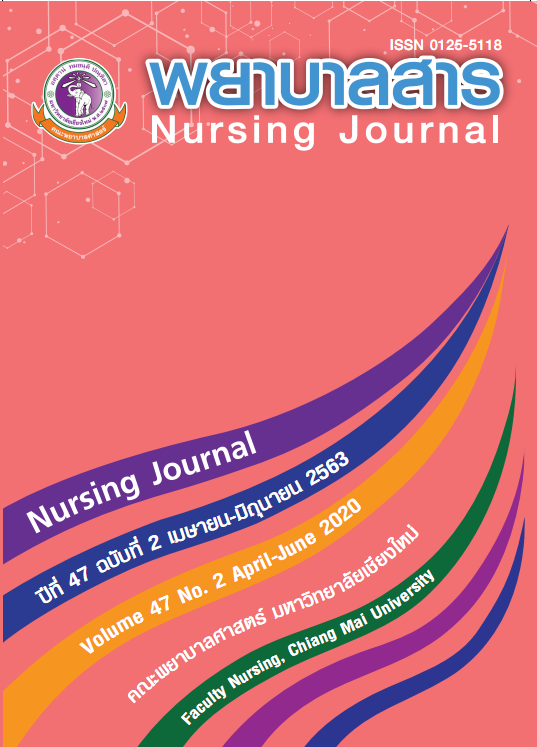Situational Analysis of Patient Safety Management, Male Surgical Ward, Buddhachinaraj Phitsanulok Hospital
Keywords:
Patient safety management, Situation analysis, Male surgery wardAbstract
Patient safety management is a crucial factor for diminishing errors on remedy and nursing care for patients in hospitals. The objective of the study was to analyze situations of patient safety management and the ways to improve patient safety management in Male Surgical Ward, Buddhachinaraj Phitsanulok Hospital. Participants included five nursing administrators and ten nursing personal. The study instruments were comprised of constructed interview guides that were tested for a clear and well-defined research interest by three experts in hospital administration. Data were collected by interviews and focus groups. Data were analyzed by using content analysis.
The findings revealed that this ward carried out patient safety management base on the model of risk and safety management system suggested by Healthcare Accreditation Institute (2015). However, many problems in the patient safety management were found as below: some nursing personnel indicated the suspicion that errors, even serious ones, were underreported; nursing personnel felt no positive changes from risk identification and prioritization; some nursing personnel did not comply with the clinical guidelines; near miss incidents were underreported; not all of the nursing personnel could participate in the RCA meeting; and the risk management team was so busy resulting in delayed feedback on what was being done to correct the problems.
According to the study findings, nursing administrators should develop strategies to stimulate incident identification and make incident reporting easier. It is important for hospital wards to get insight into their own pattern of root causes and prioritize improvement activities based on weak spots in their patient safety system. Moreover, direct and immediate feedback to nursing personnel is extremely important to keep them aware of patient safety.
References
Chanthanasombat, P., Genetics, N., & Nansuphawat, W. (2013). Effects of Educational Program on Knowledge and Attitude in Risk Management of Nopparatrajathan ee Hospital’s Staff in Nopparat Rajathanee Hospital. Journal of Nurses’ Association of Thailand, North-Eastern Divison, 31(3), 117-124. (In Thai)
Chiangwong, Y. (2014) Situational Analysis of Clinical Practice Guidelines Implementation in Orthopedics Department Nan Hospital (Master’s thesis, Chiangmai University). (In Thai)
Francolin, L., Gabriel, C. S., Bernardes, A., Silva, A. E., Brito Mde, F., & Machado, J. P. (2015). Patient safety management from the perspective of nurses. Journal of School of Nursing, 49 (2), 275-281. doi:10.1590/S0080-623420150000200013
Jirapaet, W., & Jirapaet, K. (2012). Patient safety management, concept, process, clinical safety guidelines. Bangkok: Eleven Glasses Color.
Kim, I. S., Park, M. J., Park, M. Y., Yoo, H., & Choi, J. (2013). Factors affecting the perception of importance and practice of patient safety management among hosp ital employees in Korea. Asian Nursing Research, 7, 26-32.
Kurunat, A. (2010). Development of risk management systems for hospitals (Master’s thesis, Chiangmai University). (In Thai)
Laohatima, K., & Bunit, S. (2016). Study of obstacles that affect the acceptance of computerized treatment orders. In the 8th Conference of Research Network in Technology and Innovation Management (page 41-50). Bangkok: Dhurakij Pundit University.
Limpanyert, P. (2015). World Health Organization’s patient safety course manual. Nonthaburi: The Health care Accreditation Institute. (In Thai)
Male surgery ward .(2016). Annual Report. Phitsanulok: Phutthachinnarat Hospital, Phitsanulok. (In Thai)
Nawaeng, P. (2007). The relationship between the effectiveness of safety management in the nursing service system and the level of patient safety in commu nity hospitals (Master’s thesis, Sukhothai Thammathirat University). (In Thai)
Penpradub, B. (2004). A study of problems, difficulties and attitudes of medical laboratory officers in using LIS (Laboratory Information System) in hospital within Bangkok area (Master’s thesis, Thammasat University). (In Thai)
Promsri , C. (2017). Risk management. Bangkok: Offset Creation. (In Thai)
Phoksiranuwat, M., Phakdeewong, P., & Wannasiri, C. (2014). A Development of Knowledge Management Model of High Alert Drug Administration for Head Nurses in Hospitals Under Royal. Thai ArmyJournal of the Royal Thai Army Nursing, 15(2), 81-89. (In Thai)
Pokhaphan, P., Sithongdee, S., & Tikapanyo ,C. (2012). The Quality Improvement of Clinical Risk Management System for Care Standard of In-Patient Care of Nurs es in the Fort Sunpasitthiprasong Hospital in Ubon Ratchathani Province. Journal of The Royal Thai Army Nurses, 13(2), 38. (In Thai)
Saenprasan, P. , Kalangkun, R., Fongphet, A., Sawadiwattanakul, S., & Pongkiatichai, R. (2006).Nursing management for safety (2nd ed.). Bangkok: Sukhumvit. Printing. (In Thai)
Sriratana, V. (2016). Perceived Patient Safety Management Among Nursing Personnel in Fort Surasakmontri Hospital Lampang Province (Master’s thesis, Chiangmai University). (In Thai)
Srivichai, S. (2014) Situational analysis of risk management in the sub-neonatal in tensive careunit Nakornping hospital Chiang Mai province (Independent Study, Chiangmai University). (In Thai)
Suphachutkul, A. (2000). Hospital risk management system. Bangkok: Design. (In Thai)
The Health care Accreditation Institute (Public organization). (2015). Hospital and health standards Chalermprakiat 60th Anniversary Celebrations (Thai). Nonthaburi: Hospital Development and Certification Institute.
Downloads
Published
How to Cite
Issue
Section
License
บทความที่ได้รับการตีพิมพ์เป็นลิขสิทธิ์ของวารสารพยาบาลสาร
ข้อความที่ปรากฏในบทความแต่ละเรื่องในวารสารวิชาการเล่มนี้เป็นความคิดเห็นส่วนตัวของผู้เขียนแต่ละท่านไม่เกี่ยวข้องกับมหาวิทยาลัยเชียงใหม่ และคณาจารย์ท่านอื่นๆในมหาวิทยาลัยฯ แต่อย่างใด ความรับผิดชอบองค์ประกอบทั้งหมดของบทความแต่ละเรื่องเป็นของผู้เขียนแต่ละท่าน หากมีความผิดพลาดใด ๆ ผู้เขียนแต่ละท่านจะรับผิดชอบบทความของตนเองแต่ผู้เดียว






